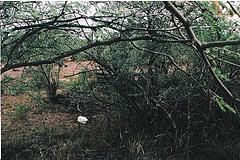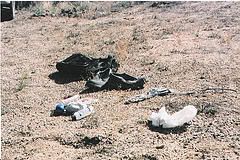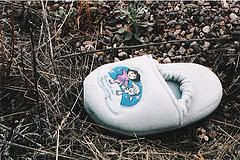Walking in the footsteps de los fantasmas
 They gathered early in the morning as the sun first began to peak over the horizon, like so many others before them. Quickly checking water bottles and backpacks to make sure all the provisions for the long journey ahead were in place. It was a scene repeated a thousand times a year in border towns in the desert southwest. As the early morning purples and reds began to give way to bright blue, the group of about seventy-five travelers gathered on the dusty road outside of Sasabe and looked out over the vast expanse of sand and rock, knowing the journey ahead would test them body and soul. It would not be long before the temperature, reaching the triple digits, would start to slowly take its toll on their bodies. As the hot sun began beating down on them relentlessly, they were all well aware that this was the same burning sun that had taken the lives of eighty five other travelers in the past seven months. For seven days they would be traveling through terrain that looked more like that of the moon than earth, trying to keep pace with the group. At 12 to 16 miles a day they would hopefully reach Tucson by weeks end.
They gathered early in the morning as the sun first began to peak over the horizon, like so many others before them. Quickly checking water bottles and backpacks to make sure all the provisions for the long journey ahead were in place. It was a scene repeated a thousand times a year in border towns in the desert southwest. As the early morning purples and reds began to give way to bright blue, the group of about seventy-five travelers gathered on the dusty road outside of Sasabe and looked out over the vast expanse of sand and rock, knowing the journey ahead would test them body and soul. It would not be long before the temperature, reaching the triple digits, would start to slowly take its toll on their bodies. As the hot sun began beating down on them relentlessly, they were all well aware that this was the same burning sun that had taken the lives of eighty five other travelers in the past seven months. For seven days they would be traveling through terrain that looked more like that of the moon than earth, trying to keep pace with the group. At 12 to 16 miles a day they would hopefully reach Tucson by weeks end.
A young boy of thirteen when asked about the journey and why anyone would risk life and limb to cross the scorching desert on foot replied, "Nobody would do this for a little extra money," he said. "This isn't about buying a nicer car. It's about putting food on your family's table." Within days, 37 year old Joann Quintanilla would no longer be able to keep up with the group, her legs cramping up from a combination of heat and exhaustion. Another woman would be nursing feet covered with blisters and bandages.
As they walked they followed a path well worn by thousands who came before them.
tags: immigration, Migrant Trail, border wall , migrant deaths, No More Deaths, oppose border wall
About two weeks before, 25 year old Edith Rodreguez, a native of Veracruz, had also left Sasabe to take a similar journey. With a group of eight or ten others led by a coyote, Rodreguez with her 3 year old son, began the long trek through the Arizona desert on May 11th.
The coyote, hoping to keep the group moving, handed each of his charges a Sedalmerk tablet before their journey began. Sedalmerk is a Mexican over-the-counter drug containing caffeine, Tylenol and ephedra – an herbal amphetamine-like drug that was banned in the US. Because of its tendency to accelerate dehydration, the drug would prove to be deadly when combined with the desert heat and arduous journey. Within two days the boy began to suffer the signs of dehydration and could no longer keep up. Rodriguez began to carry him, but as they started to fall further behind, the coyote made the decision to leave the young woman and her child behind to fend for themselves in the hot desert sun. On May 13th, as they continued their journey north through the Tohono O'odham Indian reservation the boy finally lost consciousness, but Roderguez continued on, carrying the limp body of her son.
Within two days the boy began to suffer the signs of dehydration and could no longer keep up. Rodriguez began to carry him, but as they started to fall further behind, the coyote made the decision to leave the young woman and her child behind to fend for themselves in the hot desert sun. On May 13th, as they continued their journey north through the Tohono O'odham Indian reservation the boy finally lost consciousness, but Roderguez continued on, carrying the limp body of her son.
The mother and child trekked on for one more day, but after a while she was unable to continue and placed her baby under a paloverde tree for shade and went to look for help. A few hours later she stumbled upon Highway 86, which runs through the center of the Indian lands and on the afternoon of May 15 was picked up by Border Patrol agents. Frantic, she begged the agents to send help to find her son.  In the early morning hours of May 16th, , after hours of searching and tracking Rodreguez's footprints, Border Patrol agent Dan McClafferty smelled an all too familiar smell as he approached a paloverde tree. It was the smell of death. There under the thorny branches lay the body of the small boy, covered with a jacket, his arms crossed over his chest just as his mother had left him.
In the early morning hours of May 16th, , after hours of searching and tracking Rodreguez's footprints, Border Patrol agent Dan McClafferty smelled an all too familiar smell as he approached a paloverde tree. It was the smell of death. There under the thorny branches lay the body of the small boy, covered with a jacket, his arms crossed over his chest just as his mother had left him.
The medical examiner placed the time of death between May 13 and May 14.
For Joann Quintanilla, the woman with the leg cramps, the story ended much differently, even though she admits that, "If I was in a group with a coyote, he would have left me."
She wasn't with a coyote, in fact when her cramps got bad she was ushered to one of the many support vehicles, loaded with donated food, water and medical supplies that accompanied her group on trek through the desert.
Quintanilla and the others in her group were part of the third annual "Migrant Trail" walk to draw attention to the plight of migrants who die by the hundreds trying to cross the desert each year. The walk which began on Memorial Day was intended "to draw attention to the increasing number of migrant deaths along the Arizona-Sonora border," said Kat Rodriguez with Derechos Humanos, one of the sponsors of the effort along with Community groups such as the Migrant Trail Walk Committee, American Friends Service Committee, BorderLinks, Casa Maria, the faith-based No More Deaths coalition, the Samaritans, Witness for Peace, Coloradans for Immigrant Rights and the West Coast Mennonite Central Committee. "One way or another, the deaths need to stop," Rodriguez said.
"Migrant Trail" began in 2004 with 25 participants and has grown ever since. This year perhaps there is even more urgency to their message as Washington discusses further closing of sections of the border with fences and increased military patrols.
Since 1993, when the Clinton administration began a crackdown on border crossings in San Diego and El Paso, more than 3,500 people have died trying to cross into the United States through desert. And, as officials work to put more patrols and fencing along the U.S.-Mexico border, immigrant advocates fear there will be more deaths among the tens of thousands who attempt the trip.
Most of the deaths so far -- 959 since Oct. 1, 2001, according to local government statistics and the Mexican government -- have been in Arizona, where the landscape comprises mountains, ranches, Indian reservations, military proving grounds and endless miles of cactus-filled desert….
Border Patrol statistics show that while the death toll mounts annually, the number of those apprehended while crossing the border has not changed significantly since 1993. But because federal agencies have tightened the border in urban areas, smugglers who move the men, women and children seeking to enter the United States illegally have funneled them onto increasingly perilous trails where temperatures are high, water is scarce and danger is abundant.
"All the evidence is that increased enforcement on the border has achieved no benefit at all except in additional employment of Border Patrol agents," said John Fife, a Tucson pastor and founder of No More Deaths, a coalition of charities devoted to stopping deaths during desert border crossings. "What has changed is the devastating elements of this policy. You have a number of deaths that surpasses the number of American deaths in Iraq. And yet still we are determined to persist and redouble our efforts."
Washington Post
Back on May 15th, President Bush gave his nationally televised speech on immigration, outlining his plan to send 6000 National Guard troops to the southern border.  As Bush spoke, Agent Dan McClafferty was tracking footprints through the desert in search of Edith Rodreguez's missing boy. He was getting nowhere fast in his search. By his account there were thousands of tracks in the area, making it impossible to find those of the boy's mother. Finally the Border Patrol office in Nogales faxed over an image of Rodreguez's shoeprint. McClafferty found the prints and tracked them for seven hours as they weaved and circled through the desert. "We figured she was in bad shape," McClafferty said. "She was walking around in circles. She went for help then went back to her son but couldn't find him."
As Bush spoke, Agent Dan McClafferty was tracking footprints through the desert in search of Edith Rodreguez's missing boy. He was getting nowhere fast in his search. By his account there were thousands of tracks in the area, making it impossible to find those of the boy's mother. Finally the Border Patrol office in Nogales faxed over an image of Rodreguez's shoeprint. McClafferty found the prints and tracked them for seven hours as they weaved and circled through the desert. "We figured she was in bad shape," McClafferty said. "She was walking around in circles. She went for help then went back to her son but couldn't find him."
In the end it was the smell that led McClafferty to the boy.
As the "Migrant Trail" walkers trekked through the desert two weeks later, they too followed the same path. They walked in those same thousands of footprints that Agent McClafferty had tracked only weeks before. Perhaps in the very same footprints as Edith Rodreguez while she carried her then dead baby boy to his final resting place under the paloverde tree
This year, like in years before, they walk in the footsteps of migrants. They walk in the footsteps of ghosts … they walk in the footsteps de los fantasmas. 
You can help by contacting:
No More Deaths
Derechos Humanos
Border Action Network
Humane Borders.org

































2 comments:
Thanks, Duke. This piece is just beautiful.
Thank you.
Vivian
Hi Viv,
sorry I took so long to get around to writting about the Migrant Trail..but I guess better late than never.
anyway ... thanks for all the updates from your neck of the woods
Duke
Post a Comment